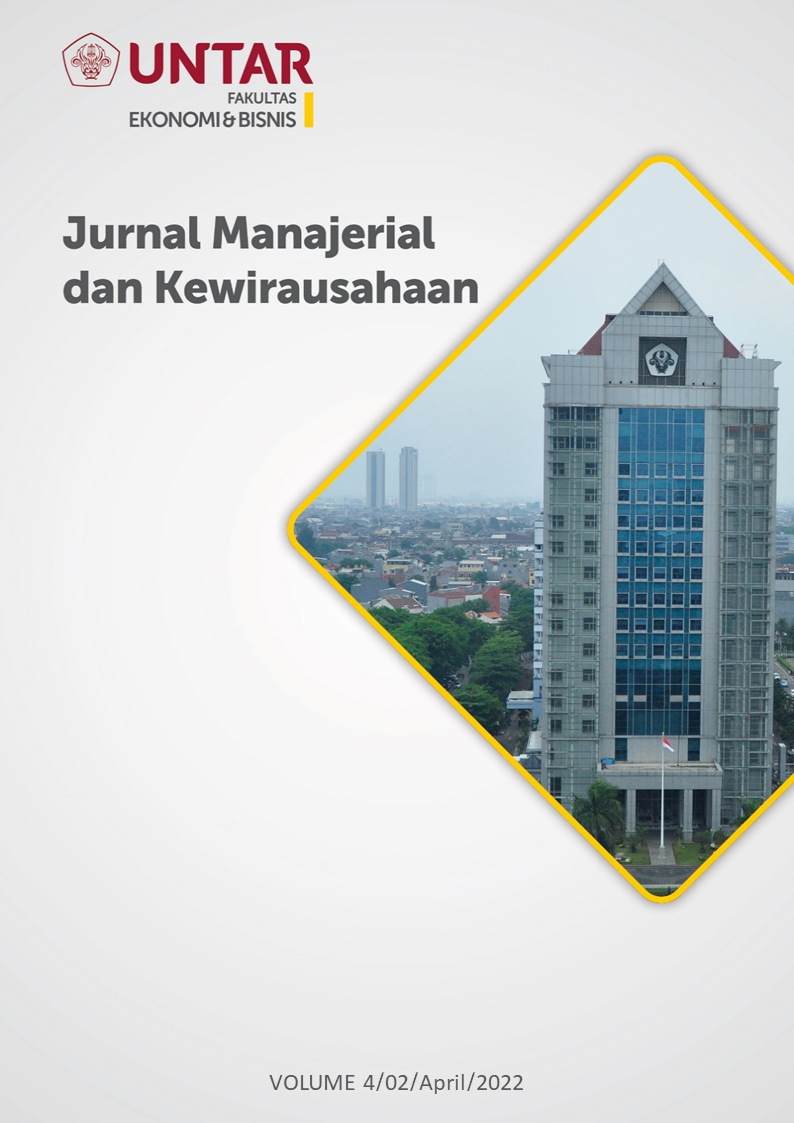Pengaruh Informativeness, Entertainment, dan Personalization terhadap Advertising Value dengan Dampaknya terhadap Purchase Intention pada Pelanggan Instagram Ambu Coffee di Cibinong
Main Article Content
Abstract
Penelitian ini bertujuan untuk mengetahui pengaruh informativeness, entertainment, dan personalization terhadap advertising value dengan dampaknya terhadap purchase intention. Subyek penelitian ini adalah pelanggan Instagram pada UMKM AMBU Coffee di Cibinong. Dalam penelitian ini, jumlah sampel sebanyak 117 responden. Metode yang digunakan untuk pengambilan sampel responden adalah dengan menggunakan metode non probability sampling secara spesifik convinience sampling. Data diolah dengan menggunakan PLS-SEM yang terdiri dari test outer model dan inner model. Hasil pada penelitian ini adalah Informativeness, Entertainment, Personalization berpengaruh signifikan dan positif terhadap Advertising Value dengan dampaknya terhadap Purchase Intention.
This study aims to determine the effect of informativeness, entertainment, and personalization on advertising value with its impact on purchase intention. The subject of this research are Instagram customers at AMBU Coffee in Cibinong. In this study, the number of sample was 117 respondents. The method used to sampling the respondents was by using non-probability sampling method specifially Convenience Sampling. The data was analysed byusing PLS-SEM which consist of a test of outer model and inner model. The results of this study showed that Informativeness, Entertainment, Personalization have a significant and positive effect on Advertising Value with impacts on the Purchase Intention.
Article Details
This work is licensed under a Jurnal Muara Ilmu Ekonomi dan Bisnis Creative Commons Attribution-ShareAlike 4.0 International License.,/p>
References
Databoks.Katadata. (2021). Inikah Negara Pengguna Instagram Terbanyak, Indonesia Urutan Berapa? Diakses kembali dari https://databoks.katadata.co.id
Databoks.Katadata. (2021). Pengguna Instagram di Indonesia Mayoritas Perempuan. Diakses kembali dari https://databoks.katadata.co.id/
Dao, W. V., Le, A. N. H., Cheng, J. M., & Chen, D. C. (2014). Social Media Advertising Value The case of transitional economies in Southeast Asia, International Journal Of Advertising, Vol. 33, No. 2, pp. 271-294.
Ducoffe, R. H. (1995). How Consumers Assess the Value of Advertising. Journal of Current Issues & Research in Advertising.
Ghozali, Imam. (2012), Aplikasi Analisis Multivariate dengan Program IBM SPSS 20.
Hair, J.F., Black, W. C., Babin, B. J., & Anderson, R. E. (2018), “Multivariate Data Analysis (8th ed.)”, United Kingdom: Cengage Learning.
Hair, J.F., Risher, J.J., Sarstedt Marko, Ringle, C. M. (2019), “When to use and how to report the results of PLS-SEM”, European Business Review, Vol.31, No. 1, pp. 224.
Hamouda, Manel. (2018). “Understanding social media advertising effect on consumer’s responses”, Journal of Enterprise Information Management, Vol. 31, No. 3, pp. 426-445.
Hendro, Hendro & Keni, Keni. (2020). eWOM dan Trust sebagai Prediktor terhadap Purchase Intention: Brand Image sebagai Variabel Mediasi. Jurnal Komunikasi, 12(2), 298 – 310. https://doi.org/10.24912/jk.v12i2.7760
Hussain, A., Abbasi, A.Z., Hollebeek, L.D., Schultz, C.D., Ting, D.H. and Wilson. B. (2021). “Videogames-as-a-service: converting freemium- to paying-users through pop-up advertisement value”, Journal of Services Marketing.
Kim, Y.J. & Han, J.Y. (2014), “Why smartphone advertising attracts customers: A model of web advertising, flow, and personalization”, Computers in Human Behavior, 33, 256-269.
Komar, H. & Tunjungsari, H. K. (2019). Pengaruh Online Behavioural Advertising Dan Consumer Trust Pada Sikap Dan Niat Konsumen Merespon Online Advertising. Jurnal Muara Ilmu Ekonomi dan Bisnis, 3(1), 71-81. https://doi.org/10.24912/jmieb.v3i1.3354
Kompasiana. (2021). Peran UMKM dalam Meningkatkan Perekonomian Masyarakat Cibinong. Diakses kembali dari https://www.kompasiana.com/
Le, C.X. & Wang, H. (2021), “Integrative perceived values influencing consumers’ attitude and behavioral responses toward mobile location-based advertising: an empirical study in Vietnam”, Asia Pacific Journal of Marketing and Logistics, Vol. 33 No. 1, pp. 275-295.
Le, T.D. & Nguyen, B.T.H. (2014), “Attitudes Toward Mobile Advertising: A Study of Mobile Web Display and Mobile App Display Advertising”, Asian Academy of Management Journal, Vol. 19, No2, pp 87-103.
Lee, E.B., Lee, S.G. and Yang, C.G. (2016), “The influences of advertisement attitude and brand attitude on purchase intention of smartphone advertising”, Industrial Management & Data Systems, Vol. 117 No. 6, pp. 1011-1036.
Logan, K., Bright, L.F. and Gangadharbatla, H. (2012), “Facebook versus television: advertising value perceptions among females”, Journal of Research in Interactive Marketing, Vol. 6 No. 3, pp. 164-179.
Madahi, A. & Sukati, I. (2012), “The Effect of External Factors on Purchase Intention amongst Young Generation in Malaysia”, International Business Research, Vol. 5, No. 8.
Malhotra, Naresh K. (2015), “Essentials of Marketing Research: A Hands-on Orientation, 1st edition”, New Jersey, England: Pearson Education.
Oh, L.B. & Xu Heng. (2003), “Effects of Multimedia on Mobile Consumer Behavior: An Empirical Study of Location-Aware Advertising”, International Conference on Information Systems, 56.
Veloceinternational. (2017). Instagram Statistics and Facts You Need to Know. Diakses dari https://www.veloceinternational.com
Wang, C., Zhang, P., Choi, R., D’Eredita, M. (2002), “Understanding Consumers Attitude Toward Advertising”, Americas Conference on Information Systems, 158.
Wu, P.C.S., Yeh, G.Y.Y., Hsiao, C.R. (2011), “The effect of store image and service quality on brand image and purchase intention for private label brands”, Australian Marketing Journal, 19, 30-39.
Zeithaml, V., Parasuraman, A.P. and Malhotra, A. (2000), “A conceptual framework for understanding e-service quality: implications for future research and managerial practice”, Journal of Marketing, Vol. 49, pp. 41-50.


